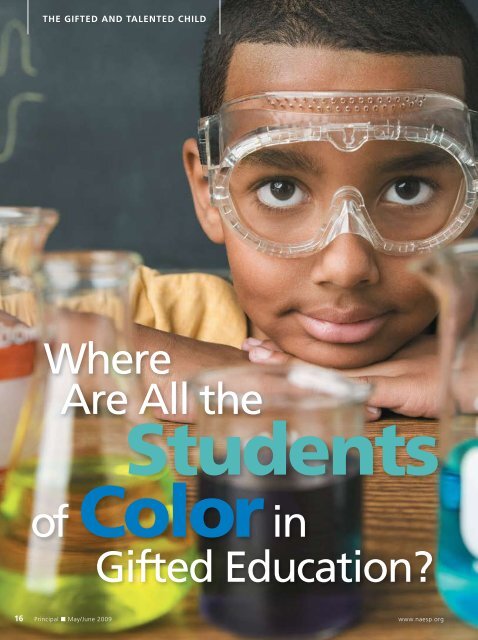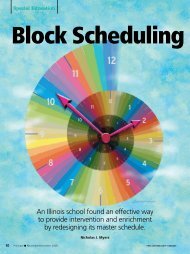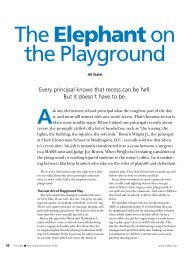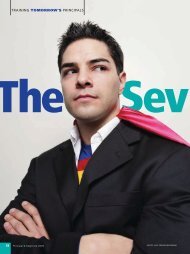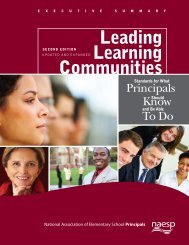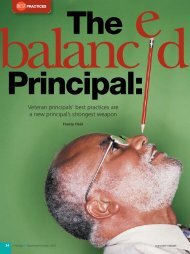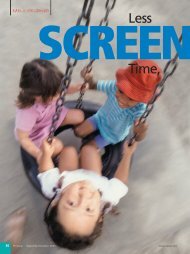Where Are All the Students of Color in Gifted Education? - National ...
Where Are All the Students of Color in Gifted Education? - National ...
Where Are All the Students of Color in Gifted Education? - National ...
- No tags were found...
You also want an ePaper? Increase the reach of your titles
YUMPU automatically turns print PDFs into web optimized ePapers that Google loves.
<strong>the</strong> gIFteD AND tAleNteD chIlD<strong>Where</strong><strong>Are</strong> <strong>All</strong> <strong>the</strong><strong>Students</strong><strong>of</strong> <strong>Color</strong> <strong>in</strong><strong>Gifted</strong> <strong>Education</strong>?16 Pr<strong>in</strong>cipal n May/June 2009www.naesp.org
New strategiesare open<strong>in</strong>ggifted programsto culturallyand l<strong>in</strong>guisticallydiverse students.Kathleen A. K<strong>in</strong>g, elizabeth b. Kozleski,and Kimberly lansdownehIll stReet stUDIOs/PhOtOlIbRARy<strong>the</strong> Equity <strong>All</strong>ianceat Arizona StateUniversity is one <strong>of</strong>10 regional Equity AssistanceCenters <strong>in</strong> <strong>the</strong> U.S.that are funded by <strong>the</strong> U.S.Department <strong>of</strong> <strong>Education</strong>to support <strong>the</strong> work <strong>of</strong> <strong>the</strong>Office <strong>of</strong> Civil Rights and<strong>the</strong> Department <strong>of</strong> Justice<strong>in</strong> enforc<strong>in</strong>g federal civilrights laws. While <strong>the</strong> efforts<strong>of</strong> <strong>the</strong> Office <strong>of</strong> Civil Rightshave improved educationalopportunities for formerlyexcluded and marg<strong>in</strong>alizedstudents, <strong>the</strong>re is still muchwork to be done to addressachievement gaps and toensure that all students areprovided with high-qualityeducation (Artiles, Rueda,Salazar, & Higareda, 2005;Donovan & Cross, 2002;Kl<strong>in</strong>gner, Méndez Barletta,& Hoover, 2008; Losen &Orfield, 2002).Pr<strong>in</strong>cipal n May/June 2009 17
Many pr<strong>in</strong>cipals across <strong>the</strong> U.S., work<strong>in</strong>gwith regional assistance centerslike <strong>the</strong> Equity <strong>All</strong>iance, are presentlyengaged <strong>in</strong> explor<strong>in</strong>g and improv<strong>in</strong>g<strong>the</strong> quality <strong>of</strong> learn<strong>in</strong>g opportunities forstudents who are culturally and l<strong>in</strong>guisticallydiverse (CLD). The need for suchwork has been recognized <strong>in</strong> <strong>the</strong> fields<strong>of</strong> special and gifted education.While most concerns lie with <strong>the</strong>disproportionately higher number <strong>of</strong>CLD students who are placed <strong>in</strong> specialeducation, <strong>the</strong>re are also concernsabout <strong>the</strong> under-representation <strong>of</strong>CLD students who are identified as gifted.For <strong>in</strong>stance, while black studentsmade up 7.4 percent <strong>of</strong> <strong>the</strong> total schoolenrollment <strong>in</strong> California <strong>in</strong> 2007(California Department <strong>of</strong> <strong>Education</strong>,2008c), <strong>the</strong>y accounted for 22 percent<strong>of</strong> all students identified as emotionallydisturbed (California Department<strong>of</strong> <strong>Education</strong>, 2008b), and only 4.13percent <strong>of</strong> those <strong>in</strong> gifted and talentededucational programm<strong>in</strong>g (CaliforniaDepartment <strong>of</strong> <strong>Education</strong>, 2008a). On<strong>the</strong> contrary, white students, who madeup 28.5 percent <strong>of</strong> <strong>the</strong> total studentenrollment, accounted for 41.7 percent<strong>of</strong> gifted and talented enrollment(California Department <strong>of</strong> <strong>Education</strong>,2008c, 2008a).An Unmet NeedThe field <strong>of</strong> gifted education <strong>in</strong> <strong>the</strong>United States, much like special education,is grounded <strong>in</strong> beliefs that somestudents demonstrate a need for specializededucation that, historically andcurrently, has not been provided <strong>in</strong> U.S.public schools. Special and gifted educationscholars and practitioners alikerecognize that opportunities to learnneed to be improved so that all studentshave equitable educational access andparticipation. Yet, as pr<strong>in</strong>cipals striveto achieve this goal, <strong>the</strong>y <strong>of</strong>ten experiencetensions around: <strong>the</strong> purpose,scope, and location <strong>of</strong> <strong>the</strong> education<strong>the</strong>y provide; <strong>the</strong> preparation <strong>of</strong> teachersfor an <strong>in</strong>creas<strong>in</strong>gly diverse studentpopulation; and determ<strong>in</strong><strong>in</strong>g <strong>the</strong> extentto which <strong>the</strong> needs for specialized<strong>in</strong>struction create educational fieldsseparate from general education.Although specific federal mandates(i.e., <strong>the</strong> Individuals with Disabilities<strong>Education</strong> Act <strong>of</strong> 2004; Section 504 <strong>of</strong><strong>the</strong> Rehabilitation Act) provide someguidance for address<strong>in</strong>g <strong>the</strong> needs <strong>of</strong>students with disabilities, <strong>the</strong>re are nosimilar mandates for gifted educationservices.Recruitment and RetentionFord, Grantham, and Whit<strong>in</strong>g (2008)note that black, Hispanic, and NativeAmerican students have always beenunder-represented <strong>in</strong> gifted education,and that this under-representation has<strong>in</strong>creased over time for black students<strong>in</strong> particular (Ford, 1998). Pr<strong>in</strong>cipalscan confront this issue by:n Address<strong>in</strong>g lower expectations <strong>of</strong>CLD students through pr<strong>of</strong>essionallearn<strong>in</strong>g and teacher preparationthat is grounded <strong>in</strong> multiculturaland culturally responsive pedagogyand practice. The <strong>National</strong> Centerfor Culturally Responsive <strong>Education</strong>alSystems has many tools pr<strong>in</strong>cipalscan use.n Adopt<strong>in</strong>g culturally responsivedef<strong>in</strong>itions <strong>of</strong> giftedness, explicitlyacknowledg<strong>in</strong>g that giftednessoccurs across gender and cultural,l<strong>in</strong>guistic, and <strong>in</strong>come groups.Pr<strong>in</strong>cipals should work with districtadm<strong>in</strong>istrators, school psychologists,and classroom teachers to exam<strong>in</strong>e<strong>the</strong> current def<strong>in</strong>itions <strong>of</strong> giftednessand work to ensure <strong>the</strong>se def<strong>in</strong>itionsconvey that giftedness is found <strong>in</strong>students <strong>of</strong> all backgrounds and lifeexperiences.n Broaden<strong>in</strong>g def<strong>in</strong>itions <strong>of</strong> giftednessto <strong>in</strong>clude those students who underachieveas well as those who achieveat or above comparison groups. <strong>Gifted</strong>nessshould not be reserved onlyfor those students who are achiev<strong>in</strong>ghigh grades or test scores.n Build<strong>in</strong>g systemic evaluation <strong>of</strong>under-representation <strong>of</strong> CLD students<strong>in</strong>to evaluation <strong>of</strong> all giftededucation programs and services.Pr<strong>in</strong>cipals should cont<strong>in</strong>uouslyassess, on a year-to-year basis, <strong>the</strong>racial, ethnic, gender, and l<strong>in</strong>guisticdemographics <strong>of</strong> students access<strong>in</strong>ggifted <strong>in</strong>structional programm<strong>in</strong>g,as compared with <strong>the</strong> demographics<strong>of</strong> all students.One District’s MissionIn our work at <strong>the</strong> Equity <strong>All</strong>iance, <strong>in</strong>conjunction with <strong>the</strong> <strong>National</strong> Centerfor Culturally Responsive <strong>Education</strong>alSystems and <strong>the</strong> <strong>National</strong> Institute forUrban School Improvement, we haveexam<strong>in</strong>ed <strong>the</strong> efforts <strong>of</strong> local school districtsthat are address<strong>in</strong>g <strong>the</strong> problem <strong>of</strong>under-representation <strong>of</strong> CLD studentsidentified as gifted and talented. One18 Pr<strong>in</strong>cipal n May/June 2009www.naesp.org
such district is Scottsdale, Arizona.In 2004, <strong>the</strong> Scottsdale UnifiedSchool District discovered large discrepanciesbetween <strong>the</strong> racial and ethnicdemographics <strong>of</strong> <strong>the</strong> overall studentpopulation and <strong>the</strong> demographics <strong>of</strong><strong>the</strong> student population <strong>in</strong> gifted educationprograms at its Title 1 schools.While white students represented only38 percent <strong>of</strong> <strong>the</strong> overall population,<strong>the</strong>y made up 72 percent <strong>of</strong> those <strong>in</strong> <strong>the</strong>gifted education program. Conversely,Lat<strong>in</strong>o students represented 50 percent<strong>of</strong> <strong>the</strong> overall population, yet made uponly 14 percent <strong>of</strong> <strong>the</strong> gifted studentpopulation. Under <strong>the</strong> direction <strong>of</strong>Kimberly Lansdowne, director <strong>of</strong> giftedstudent services, <strong>the</strong> district began athree-year action research project todeterm<strong>in</strong>e ways to identify CLD studentswho qualified for gifted learn<strong>in</strong>gprograms (Lansdowne, 2008).As a first step, <strong>the</strong> district systematicallydistributed teachers who were“Pr<strong>in</strong>cipals shouldcont<strong>in</strong>uously assess,on a year-to-yearbasis, <strong>the</strong> racial, ethnic,gender, and l<strong>in</strong>guisticdemographics <strong>of</strong>students access<strong>in</strong>ggifted <strong>in</strong>structionalprogramm<strong>in</strong>g.”qualified <strong>in</strong> both gifted educationand teach<strong>in</strong>g English-language learnersto its five Title 1 schools. In all <strong>of</strong>its schools, <strong>the</strong> district developed andimplemented curriculum that was culturallyresponsive, pay<strong>in</strong>g special attentionto Lat<strong>in</strong>o students.Next, <strong>the</strong> district looked more closelyat <strong>the</strong> methods used to identify andrecruit students for <strong>the</strong> gifted educationprogram and compared those methodsaga<strong>in</strong>st criteria for culturally responsiveassessment, <strong>in</strong>clud<strong>in</strong>g ways that studentsdemonstrated <strong>the</strong>ir knowledge, learn<strong>in</strong>g,and talents. The district beganus<strong>in</strong>g <strong>the</strong> Javits <strong>Gifted</strong> CharacteristicsChecklist for Underrepresented <strong>Students</strong>as part <strong>of</strong> its process <strong>of</strong> assess<strong>in</strong>gmultiple criteria <strong>in</strong> order to create a“thick picture” (Castellano, 2003) <strong>of</strong>students’ skills and abilities. This checklistmoves beyond collect<strong>in</strong>g evidence<strong>of</strong> <strong>in</strong>dividual academic achievement<strong>in</strong> school sett<strong>in</strong>gs by focus<strong>in</strong>g also onstudents’ abilities to work collaboratively<strong>in</strong> groups, to question and challengerout<strong>in</strong>e procedures, and to relate wellto peers and adults <strong>in</strong> <strong>in</strong>formal sett<strong>in</strong>gsand with <strong>in</strong>formal language.Consequently, more students fromCLD backgrounds were selected forgifted and talented developmentTeach<strong>in</strong>gDiverse Groups <strong>of</strong> <strong>Students</strong>is a Challenge<strong>Are</strong> you faced with teach<strong>in</strong>g ma<strong>the</strong>matics to<strong>in</strong>creas<strong>in</strong>gly diverse groups <strong>of</strong> students <strong>in</strong> yourclassroom? Learn how connect<strong>in</strong>g real-life activitieswith ma<strong>the</strong>matical concepts, and build<strong>in</strong>g onstudents’ knowledge and experiences, can help <strong>the</strong>mexcel <strong>in</strong> <strong>the</strong> classroom. These books provide:• Articles written by teachers• Instructional strategies• Classroom activitiesVisit www.nctm.org/catalog for more<strong>in</strong>formation or to place an order.bksdiv_prncpl509 Pr<strong>in</strong>cipal magaz<strong>in</strong>e 5/09www.naesp.org Pr<strong>in</strong>cipal n May/June 2009 19
opportunities and were provided withsupplemental learn<strong>in</strong>g experiences,<strong>in</strong>clud<strong>in</strong>g field trips to museums andscience/nature centers. Familiesbecame <strong>in</strong>volved by participat<strong>in</strong>g <strong>in</strong>open houses, family game nights, andParent University, which addressed topicsrelated to characteristics <strong>of</strong> giftedlearners and how to address students’strengths and needs.A survey <strong>of</strong> May 2008 data showeda 357 percent <strong>in</strong>crease <strong>of</strong> gifted studentsidentified, and <strong>of</strong> this impressive<strong>in</strong>crease Lat<strong>in</strong>o students accounted for<strong>the</strong> largest percentage <strong>of</strong> ga<strong>in</strong>. Currently,<strong>the</strong> ethnic population <strong>of</strong> Scottsdale’sgifted programs more closely mirrors<strong>the</strong> ethnic population <strong>of</strong> <strong>the</strong> district’sTitle 1 schools. For example, whitestudents account for 40 percent <strong>of</strong><strong>the</strong> overall Title 1 school population,and make up 41 percent <strong>of</strong> <strong>the</strong>gifted student population. Lat<strong>in</strong>o studentsrepresent 47 percent <strong>of</strong><strong>the</strong> school population and make up41 percent <strong>of</strong> <strong>the</strong> gifted studentpopulation.A Focus on giftednessA focus on giftedness and f<strong>in</strong>d<strong>in</strong>gstudent strengths is a powerful strategyfor discover<strong>in</strong>g and encourag<strong>in</strong>g <strong>the</strong>development <strong>of</strong> <strong>the</strong> multicultural assetsthat students br<strong>in</strong>g with <strong>the</strong>m to school.As teachers ga<strong>in</strong> more confidence <strong>in</strong>us<strong>in</strong>g <strong>the</strong> self-directed strategies <strong>of</strong>tenemployed <strong>in</strong> gifted education programs,pr<strong>in</strong>cipals will f<strong>in</strong>d teachers transferr<strong>in</strong>gthose strategies and approaches toeveryday practice <strong>in</strong> <strong>the</strong>ir classrooms.It will be important to exam<strong>in</strong>e how anemphasis on gifted <strong>in</strong>struction changesreferrals to special education as well asto gifted education.The representation <strong>of</strong> CLD students<strong>in</strong> gifted education is just one area <strong>of</strong>focus with<strong>in</strong> a much larger mission <strong>of</strong>creat<strong>in</strong>g equitable access and participation<strong>in</strong> <strong>in</strong>struction and pedagogythat is matched to students’ strengthsand needs. Pr<strong>in</strong>cipals should contact<strong>the</strong>ir regional Equity AssistanceCenter for strategies that can provideequity for CLD students <strong>in</strong> <strong>the</strong>ir giftedprograms. PKathleen A. K<strong>in</strong>g is co-director <strong>of</strong>Technical Assistance and Pr<strong>of</strong>essionalLearn<strong>in</strong>g for <strong>the</strong> Equity <strong>All</strong>iance atArizona State University. Her e-mailaddress is kathleen.a.k<strong>in</strong>g@asu.edu.elizabeth b. Kozleski, a pr<strong>of</strong>essor <strong>of</strong>curriculum and <strong>in</strong>struction at ASU, ispr<strong>in</strong>cipal <strong>in</strong>vestigator for <strong>the</strong> Equity<strong>All</strong>iance at ASU and project directorfor <strong>the</strong> <strong>National</strong> Center for CulturallyResponsive <strong>Education</strong>al Systems and<strong>the</strong> <strong>National</strong> Institute for Urban SchoolImprovement LeadSpace Pr<strong>in</strong>cipalLeadership Project. Her email address iselizabeth.kozleski@asu.edu.Kimberly lansdowne is director <strong>of</strong>gifted programs at <strong>the</strong> ScottsdaleUnified School District <strong>in</strong> Arizona. Here-mail address is kimberly.lansdowne@asu.edu.ReferencesArtiles, A. J., Rueda, R., Salazar, J. J., &Higareda, I. (2005). With<strong>in</strong>-groupdiversity <strong>in</strong> m<strong>in</strong>ority disproportionaterepresentation: English languagelearners <strong>in</strong> urban school districts.Exceptional Children, 71, 283-300.California Department <strong>of</strong> <strong>Education</strong>.(2008a). Special education enrollment byethnicity and disability statewide report.Retrieved December 8, 2008, fromhttp://dq.cde.ca.gov/dataquest/SpecEd/SEEnrEthDis1.asp?cChoice=SEEthDis1&cLevel=State&cYear=2007-08&ReptCycle=DecemberCalifornia Department <strong>of</strong> <strong>Education</strong>.(2008b). State enrollment byethnicity. Retrieved December8, 2008, from http://dq.cde.ca.gov/dataquest/EnrollEthState.asp?Level=State&TheYear=2007-08&cChoice=EnrollEth1&p=2California Department <strong>of</strong> <strong>Education</strong>.(2008c). Statewide GATE enrollment.Retrieved December 8, 2008, fromhttp://dq.cde.ca.gov/dataquest/Gate1.asp?RptYear=2007-08&TheRpt=StGate&cChoice=StGate&cYear=2007-08&cLevel=State&cTopic=Enrollment&myTimeFrame=SCastellano, J. A. (2003). Special populations<strong>in</strong> gifted education: Work<strong>in</strong>g with diversegifted learners. Boston: <strong>All</strong>yn & Bacon.Donovan, M. S., & Cross, C. T. (Eds.).(2002). M<strong>in</strong>ority students <strong>in</strong> specialand gifted education. Wash<strong>in</strong>gton, DC:<strong>National</strong> Academies Press.Ford, D. Y. (1998). The under-representation<strong>of</strong> m<strong>in</strong>ority students <strong>in</strong> gifted education:Problems and promises <strong>in</strong> recruitmentand retention. The Journal <strong>of</strong> Special<strong>Education</strong>, 32, 4-14.Ford, D. Y., Grantham, T. C., & Whit<strong>in</strong>g, G.W. (2008). Culturally and l<strong>in</strong>guisticallydiverse students <strong>in</strong> gifted education:Recruitment and retention issues.Exceptional Children, 74, 289-306.Kl<strong>in</strong>gner, J., Méndez Barletta, L., & Hoover,J. (2008). Response to <strong>in</strong>terventionmodels and English language learners.In J. K. Kl<strong>in</strong>gner, J. Hoover, & L. Baca(Eds.), English language learners whostruggle with read<strong>in</strong>g: Language acquisitionor learn<strong>in</strong>g disabilities? (pp. 37-56).Thousand Oaks, CA: Corw<strong>in</strong> Press.Lansdowne, K. (2008). Potentiat<strong>in</strong>g giftednessand <strong>the</strong> crisis <strong>of</strong> cultural bias <strong>in</strong> identify<strong>in</strong>ggifted m<strong>in</strong>ority students: Approaches to<strong>in</strong>creas<strong>in</strong>g participation <strong>of</strong> m<strong>in</strong>orities <strong>in</strong>programs for gifted learners. Unpublisheddoctoral dissertation, Arizona StateUniversity.Losen, D. J., & Orfield, G. ( 2002).Racial <strong>in</strong>equity <strong>in</strong> special education.Cambridge, MA: Harvard <strong>Education</strong>alPress.WEB RESOURCESThe <strong>National</strong> Center for CulturallyResponsive <strong>Education</strong>al Systemsprovides many resources for pr<strong>in</strong>cipals,such as pr<strong>of</strong>essional learn<strong>in</strong>g modulesand rubrics for assess<strong>in</strong>g culturallyresponsive practices <strong>in</strong> districts andschools.www.nccrest.orgAccess <strong>the</strong> Javits <strong>Gifted</strong> CharacteristicsChecklist for Underrepresented<strong>Students</strong>.www.azed.gov/asd/gifted/downloads/Project%20brighthorizongiftedcharacteristicschecklist.pdfThe Web site <strong>of</strong> <strong>the</strong> Equity <strong>All</strong>ianceat ASU is a clear<strong>in</strong>ghouse for students,families, and educators <strong>of</strong> all roles whoare concerned with atta<strong>in</strong><strong>in</strong>g equitableeducational systems.www.equityallianceatasu.org20 Pr<strong>in</strong>cipal n May/June 2009www.naesp.org


